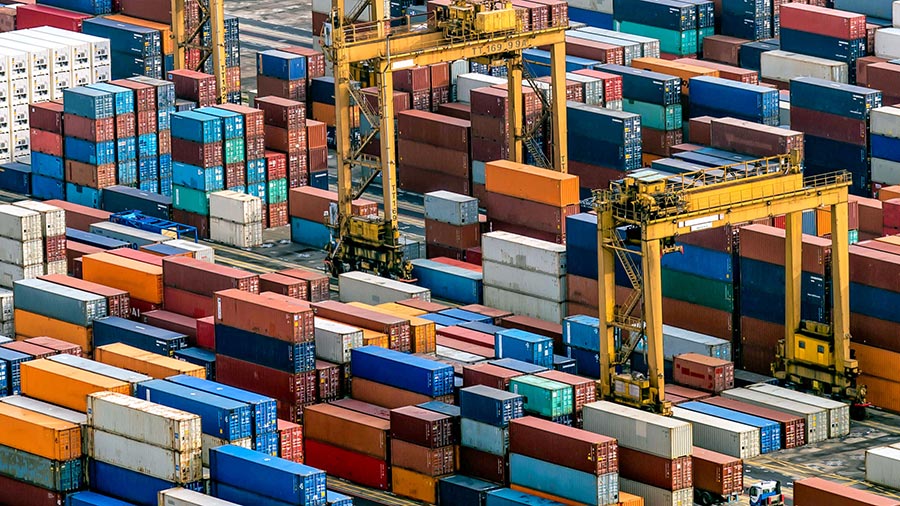Drayage is a shipping logistics term for transporting goods over a short distance. The term can also refer to the fee paid for such services, or the vehicle used to collect goods at a port or border.
There’s plenty that happens between the time products are manufactured and the time they’re delivered to the customer. But one of the most vital steps in that process are the short trips between different modes of transportation—these transfers are known as drayage.
Drayage is one of the most integral aspects of supply chain management, but it’s also one of the most misunderstood. This article will thoroughly explain all things drayage, including how it impacts shipping efficiency.
What is drayage and why is it important?
Drayage means moving cargo over a short distance on the way to its last mile carrier—usually from a transportation hub to a warehouse, or vice versa. This distance is usually covered in 1-2 hours and is the first part of a longer, overall move.
For example, if a shipping container arrives from Asia to an ocean port in Los Angeles, moving the container from the port to a nearby rail yard would be classified as drayage.
These brief handoffs might seem insignificant when considering cargo has to move hundreds or even thousands of miles. But drayage can make or break a company’s supply chain strategy. If there are delays, miscommunications, or bottlenecks with drayage loads, it can cause a ripple effect across the entire supply chain.
Think of drayage like the first mile of a marathon: it’s important for the runner to set the tone with a great start, otherwise it can throw off the whole race.
Every year, approximately 30 million marine containers move in and out of the United States. All of these containers require multiple drayage moves. If the first leg of the journey doesn’t go smoothly, the odds of a successful delivery decrease.
Drayage is especially important when time-sensitive deliveries are at stake. Take two-day shipping, for example: without a perfectly-executed drayage strategy, customers won’t receive their items by the guaranteed delivery date.
As the manufacturing industry grows, drayage will become even more important. In fact, the global drayage services market is expected to grow by nearly $3 billion by 2025, according to Technavio.
Drayage classifications
There are several types of drayage, depending on the nature of the business and/or products being shipped. Here are the primary classifications, according to the Intermodal Association of North America (IANA):
- Inter-carrier drayage: The most common type of drayage, which refers to moving goods between carriers—for example, moving items from a rail ramp to a trucking terminal.
- Intra-carrier drayage: This involves moving goods to two different hubs that are owned by the same carrier.
- Expedited drayage: This service is for moving freight containers for time-sensitive deliveries. Examples include overnight or two-day shipping.
- Door-to-door drayage: This refers to goods transported straight to a customer, rather than a warehouse or store.
- Shuttle drayage: This drayage service involves transferring an intermodal unit to a temporary holding point. This method is often used when there are bottlenecks at the origin hub.
- Port drayage: Also called pier drayage, this refers to transporting cargo from a rail terminal to a port for ocean shipping.
Most drayage moves are round-trip, since the goal is to return shipping containers back to the port as soon as possible.
Why is it called ‘drayage?’ A brief history
If “drayage” sounds like an old-fashioned term, that’s because it is.
The term drayage originates from “dray,” meaning to transport by a sideless cart. These carts, pulled by dray horses, were used to transport goods in the 1800s. The distances of the dray shipments were limited to how far the horse could haul them.
Luckily, we have drayage trucks today instead of drayage horses. But the importance of short-haul shipping remains the same.
What is multimodal transport?
Multimodal transport (also called multimodal shipping) is the process of moving goods using multiple forms of transportation. For example, transporting a shipment of tires to their final drop-off point may require a combination of container ships, freight trucks, and rail carriers.
Multimodal transport is managed under one contract, where a provider coordinates between a network of smaller carriers or contractors to complete the shipment.
Multimodal transport stands in contrast to intermodal transport, which involves separate contracts for each individual leg of the delivery. Intermodal shipping allows for goods to be handled differently depending on the carrier.
5 Best practices to reduce freight and shipping costs
Shipping costs represent a large chunk of your budget, especially as the business scales. Fortunately, there are strategies you can implement to cut down on excess spending and streamline operations.
Take advantage of order management software
Order management systems (OMS) enable organizations to manage all aspects of tracking and fulfilling orders. That includes demand forecasting, order processing, and invoicing.
QuickBooks Enterprise is packed with features designed to optimize and automate order management from ship to shelf. With 360-degree visibility across your entire system, you can pinpoint which items are in stock, what’s on order, and where each item is located so you can make real-time business decisions.
Evaluate your transportation options
There are three main ways to transport goods: ocean, air, and ground. For international shipping, ocean is almost always cheaper than air. For shipments in the same metropolitan area, railroads can be cheaper than truckers.
It’s also worth noting that combining multiple transportation options can save money and expedite delivery times (that’s where drayage comes in).
Consolidate your cargo
Consolidation simply means combining smaller shipments into larger shipments. This can significantly reduce shipping costs, labor costs, and emissions since you’re maximizing space on the vehicle.
The tradeoff with consolidation is that it can take more time for goods to arrive.
Ship more, less often
One of the best ways to cut shipping costs is by encouraging customers to buy in bulk, instead of an as-needed basis. For example, shipping 10 pallets in one day is cheaper than shipping one pallet a day. You can incentivize this by offering benefits like bulk order discounts.
Ship off-peak
It’s usually cheaper to ship goods on low-traffic days, such as Monday or Friday. However, this might not be a viable option if your cargo is perishable or you have strict delivery deadlines.
How QuickBooks Enterprise supports freight and shipping efficiency
Optimizing your shipping process is key to meeting customer expectations in a competitive marketplace. There are countless variables along the supply chain, but QuickBooks Enterprise is built to streamline your operations so you can focus more on your business goals and less on logistics.
From automated inventory forecasting to vendor management to custom reporting you’ll have all the tools you need for efficient shipping at your fingertips.














